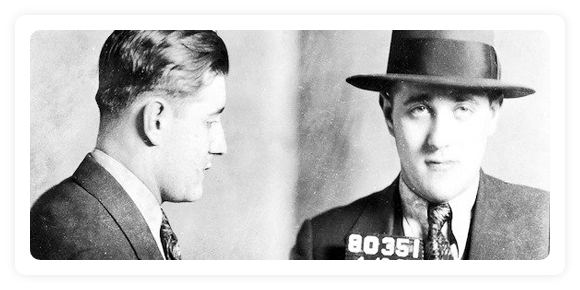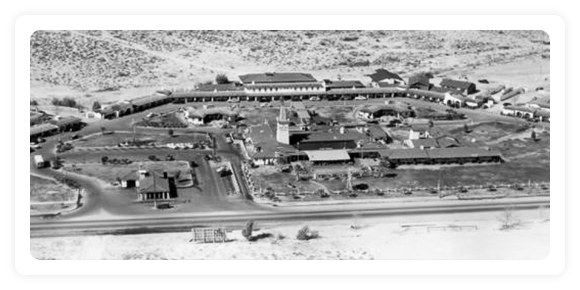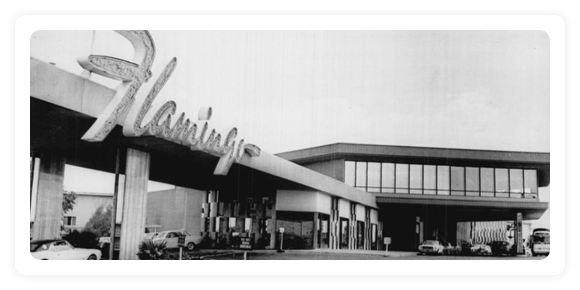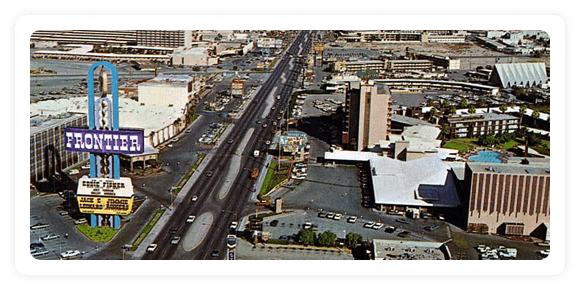
The Birth of Las Vegas
How a Mobster Revolutionized Gambling
Article by
Updated by Alejandro Dalby Dec 19, 2025
There are many misconceptions regarding how Las Vegas came to be, some perpetuated by Hollywood and others by urban legends and rumors. The true story of the birth of Vegas, however, is better than any of them - it's a tale of death, betrayal, political intrigue, glamor, love, a rise and a fall, and it positions Vegas at the very center of American history.

We tend to look at Las Vegas as an American staple, something that has always been there, a little oasis of gambling and nightlife in the middle of the desert. How did it come to be? Perhaps it has been there since the colonies, starting out as a small town where miners used to throw some dice after work? Or perhaps it's even older, maybe a spot where the Navajo tribe enjoyed some casual gambling decades or centuries before a single Englishman set foot on their land?
Surprisingly, the origin of Las Vegas is a much more modern one - and not nearly as grand, but, in a way, far more fascinating than anything the collective unconscious could produce. The story of Las Vegas is also the story of a mobster trying to clean the red on his ledger. It is a story of redemption not just for him, but for an entire city. A story of conspiracy, betrayal and action worthy of a big screen crime drama. A story that, while not quite as fascinating as a hundreds-years old gambling spot, feels a lot more human and palpable than those tall tales. And it is a story that is enough to fascinate every gambler around the world.
Who is Bugsy Siegel?

Benjamin Siegel, known by his popular nickname Bugsy, had a fairly typical childhood for an American at the dawn of the 20th century. He was the second son of Austria-Hungarian immigrants who, like many boys his age, was tasked with looking after his younger siblings as his working-class parents slaved away in factories for just barely enough money to support themselves, let alone their five children. And, again, like many boys his age, Bugsy eventually found himself on the wrong side of the law as he tried to procure a living for his siblings. By his teenage years, Bugsy had already built an impressive protection racket alongside his friend Moe Sedway, both boys racking up a mountain of criminal records as a result. There was ingenuity in them, for sure - creativity in the face of poverty and despair. But also a deep, undeniable darkness which would only dim darker as their criminal enterprise grew.
Impressed by their racket, a kid by the name of Meyer Lansky invited Bugsy and Sedway (known as The Bugs) to join up with him, giving birth to the Bugs and Meyer Mob. Now, if the name "Meyer Lansky" sounds at all familiar to you, that is only because Lansky is one of the most influential figures in the history of the American mob, and was instrumental in its exponential growth in the 30s and 40s. Today, he is known as the "Mob's Accountant", but back then, he was just another 18 year old kid looking to prove himself to the 'big boys', same as Bugsy and Sedway. The Bugs and Meyer Mob did what they had to do to rise through the ranks of organized crime. They did what they were good at… And, unfortunately, that wasn't a protection racket, it wasn't being the best at roulette, it wasn't even bootleg alcohol like so many of his contemporaries.
It was murder.
Bugsy (sometimes with Sedway and Lansky, sometimes with other members they included in their mob) became one of the most notorious assassins of the prohibition era, serving directly underneath the influential Genovese crime family. They racked up such a body count that their mob stopped being referred to as The Bugs and Meyer Mob, but instead gained a much more sinister nickname: Murder Inc. Their crime spree culminated in the assassination of Salvatore Maranzano, the father of the American mob and the person who established the notorious Five Families. Bugsy may have started as a nobody, but make no mistake: by the 1930s, he was one of the most feared criminal figures in the underworld. And it clearly affected him.
The Discovery of Las Vegas

In 1931, something happened which shook the criminal underworld forever. Al Capone, who once famously said "They can't collect legal taxes from illegal money", found himself dead wrong and in jail for tax evasion. All of a sudden, mobsters found themselves with a need to hide their illegal gains from the IRS, and the best way to do that was to circulate them through otherwise perfectly legal businesses, a practice which, today, we call "money laundering". Lansky, the Mob's Accountant, decided that a casino would serve as the perfect money laundering operation, and he tasked Bugsy and Sedway with figuring out whether this was feasible. Little did any of the three suspect that they'd find the perfect spot at the best possible time.
Remember earlier when we postulated the theory that perhaps Las Vegas' gambling scene was established for weary miners looking to relax after a day of work? Believe it or not, there's a little hint of truth in every theory. This time, it wasn't miners who needed a place for respite, but construction workers crafting the massive Hoover Dam, a landmark of 20th century American engineering.
The 5000 or so workers resided in a small town known as Las Vegas, a rather boring lot in the middle of the desert. But just as he always had, Bugsy saw potential.
This year there's 5000 workers there, what about next year? There will be 10,000, then 20,000. Many of those workers would start families and simply continue to live in Las Vegas to continue maintaining the dam. The population would grow. And they'd need entertainment.
With Lansky's blessing, Bugsy and Sedway began to establish their presence in Las Vegas. It was too early for casinos - the ground needed to be fertilized before the seeds grew. Setting up a mob presence was hard work, and not the type of glamor that Bugsy had gotten used to as an assassin superstar. As such, just as Lansky had left Las Vegas to Bugsy, Bugsy himself left it to Sedway before departing for Hollywood on a quest to expand his family's presence to the West Coast.
The Flamingo Hotel & The First Casinos

This may be a good time to mention just how much of a womanizer Bugsy was - believe us, while it seems like an unimportant detail, it's what will drive our story to the very end. Perhaps it was due to his parental neglect, or some other reason, but Bugsy was a known cheat since his teens. He married his childhood sweetheart, Esta Krakower, in 1929, and reportedly cheated on her multiple times with various women he came across, such as actress Wendy Barrie, with who he had a daughter in 1942… While still married to Esta. Awkward. Three years later, Bugsy started a relationship with Virginia Hill, a fellow New York mobster that crossed paths with him again in Hollywood. Esta Krakower finally decided that enough was enough and divorced him in 1946, leaving Bugsy to, allegedly, have a secret wedding to Hill. By all accounts, she was a woman that he cared about far more than Esta, Wendy, or any of his previous flings. The Hollywood movie "Bugsy" portrays her as the love of his life, and honestly, it doesn't seem like it was far from the truth, at least at the time.
It is not known why Bugsy decided to retire from organized crime. Perhaps it was his relationship with Virginia that made him look at life in a different way. Maybe it was the red in his ledger finally becoming too heavy to ignore. Or maybe it was a sociopathic convenience, a desire for more money with less effort.
Whatever the case may be, around the time of his marriage, Hill Bugsy returned to Las Vegas, ready to plant the seeds into the soil that his loyal partner Bee Sedway had toiled over for over a decade.
Bugsy took control of the Las Vegas syndicate from Sedway and struck a deal with a man named William R. Wilkerson, a Las Vegas real estate mogul (and the founder of popular outlet The Hollywood Reporter, which is still around to this day). Wilkerson owned a hotel known as the Flamingo, and Bugsy saw an opportunity in that property: a casino resort that could attract rich and poor from all corners of the nation.
Bugsy invested a grand total of $6 million (or $90 million in today's money) into the Flamingo, seeing it as the centerpiece of his own casino empire. It's important to note that the Flamingo was entirely legal, minus the money laundering that Bugsy's syndicate used it for, of course. But beyond that, it was a business just like any other, it paid taxes, it complied with Nevada's gambling laws, there was nothing out of the ordinary compared to any other establishment. Of course, the same could not be said about Bugsy, who, through threats, intimidation and coercion, managed to seize control of the Flamingo from Wilkerson, with the latter fleeing to Paris for his life after the fact. It appears that Bugsy couldn't fulfill the promise to himself to stay on the straight and narrow, the very promise that made him leave Hollywood with Hill. Unfortunately, this would not be his only betrayal, and would help seal his fate.
Bugsy's Death and the Rebirth of Vegas

In 1947, Bugsy would cheat on Virginia, just like he cheated on many other women before her. The woman he cheated with? None other than Bee Sedway, wife of Moe Sedway. His oldest friend, and the one who remained loyal to him throughout his entire life. It should come as no surprise at all that, only a few months later, on June 20th 1947, Bugsy Siegel was shot dead by an unknown assassin while in Beverly Hills. To this day, the murder remains unsolved, and we don't know who pulled the trigger. We can, however, make an educated guess about who ordered it, as mere minutes after the act, before the news reached the press, the Flamingo was transferred to the name of Moe Sedway - a claim which remained uncontested.
The story of Las Vegas, however, obviously doesn't end with Bugsy.
He saw the potential in Vegas as a prime spot for gambling and high-value entertainment, and as the Flamingo's success proved, he was absolutely right. After the end of World War II, when the American economy began to boom due to wartime advancements, several moguls and entrepreneurs saw to replicate the Flamingo's success by building their own hotels and casinos in the city.
Throughout the 1950s, a popular form of entertainment was to watch nuclear clouds from the atomic tests performed by the government in the desert, all while sipping on a cocktail by the roulette table. By the 1960s, infamous business magnate Howard Hughes was already staking claim to a slice of the lucrative pie that this tiny workers' town of 5000 had blossomed into over the last thirty years.
Today, Las Vegas is a household name. There are almost no people on Earth who don't know what the name refers to, and judging by its profits, quite a few of them know from experience. In 2019, the city of Vegas registered a total of $18.5 billion in profits from its various businesses, $6.5b from gambling alone. Even in 2020, with most land-based casinos experiencing restrictions and travel throughout (not to mention into) the country being very limited, they still managed to score an impressive $5b in profits. And it all started because of the dream of one man.
Make no mistake - Bugsy Siegel was a monster. Despite what he managed to achieve, it's important not to romanticize or glamorize a sexist murderer. But even so, Bugsy's story shows us that despite all the people he shot, despite all the women whose hearts he broke, ultimately Bugsy's legacy wasn't one of death and cheating. It was a city which now employs thousands of people, and has provided precious memories to millions more. And if even someone as horrible as Bugsy could create something so wonderful, imagine what the rest of us are capable of.
FAQ
Who was Bugsy Siegel and how did he contribute to Las Vegas?
Bugsy Siegel was a notorious mobster who played a crucial role in establishing Las Vegas as a gambling destination. He invested $6 million (equivalent to $90 million today) in the Flamingo Hotel, which became the first major casino resort in the city. Despite his criminal background, Siegel recognized the potential of Las Vegas as an entertainment hub, particularly with the influx of workers building the Hoover Dam.
How did Las Vegas transform from a small town to a major entertainment destination?
Las Vegas began as a small town with around 5,000 workers constructing the Hoover Dam. Bugsy Siegel saw its potential for growth and entertainment. After World War II, entrepreneurs began replicating the Flamingo's success by building more hotels and casinos. By the 1960s, the city had attracted major business magnates like Howard Hughes. In 2019, Las Vegas generated $18.5 billion in profits, with $6.5 billion from gambling alone.
What happened to Bugsy Siegel after establishing the Flamingo?
Siegel was murdered on June 20th, 1947, in Beverly Hills by an unknown assassin. The murder remains unsolved, though it's believed to be connected to his betrayal of his longtime friend Moe Sedway by having an affair with Sedway's wife. Immediately after his murder, the Flamingo was transferred to Moe Sedway's name, suggesting potential involvement in his death.

Written by
Jacob Evans
Content Writer & Casino Specialist
I'm Jacob Evans, your go-to expert in online gambling. With a robust background in casino gaming and a knack for breaking down complex betting strategies, I'm here to guide you through online casinos, sharing tips to help novices and seasoned bettors excel.

Facts checked by
Alejandro Dalby
Content Writer & iGaming Specialist
I'm an experienced writer specializing in casino games. My journey in the iGaming industry has equipped me with a deep understanding of gaming strategies and market trends. I'm here to share my insights and help you navigate the exciting world of online gambling.



